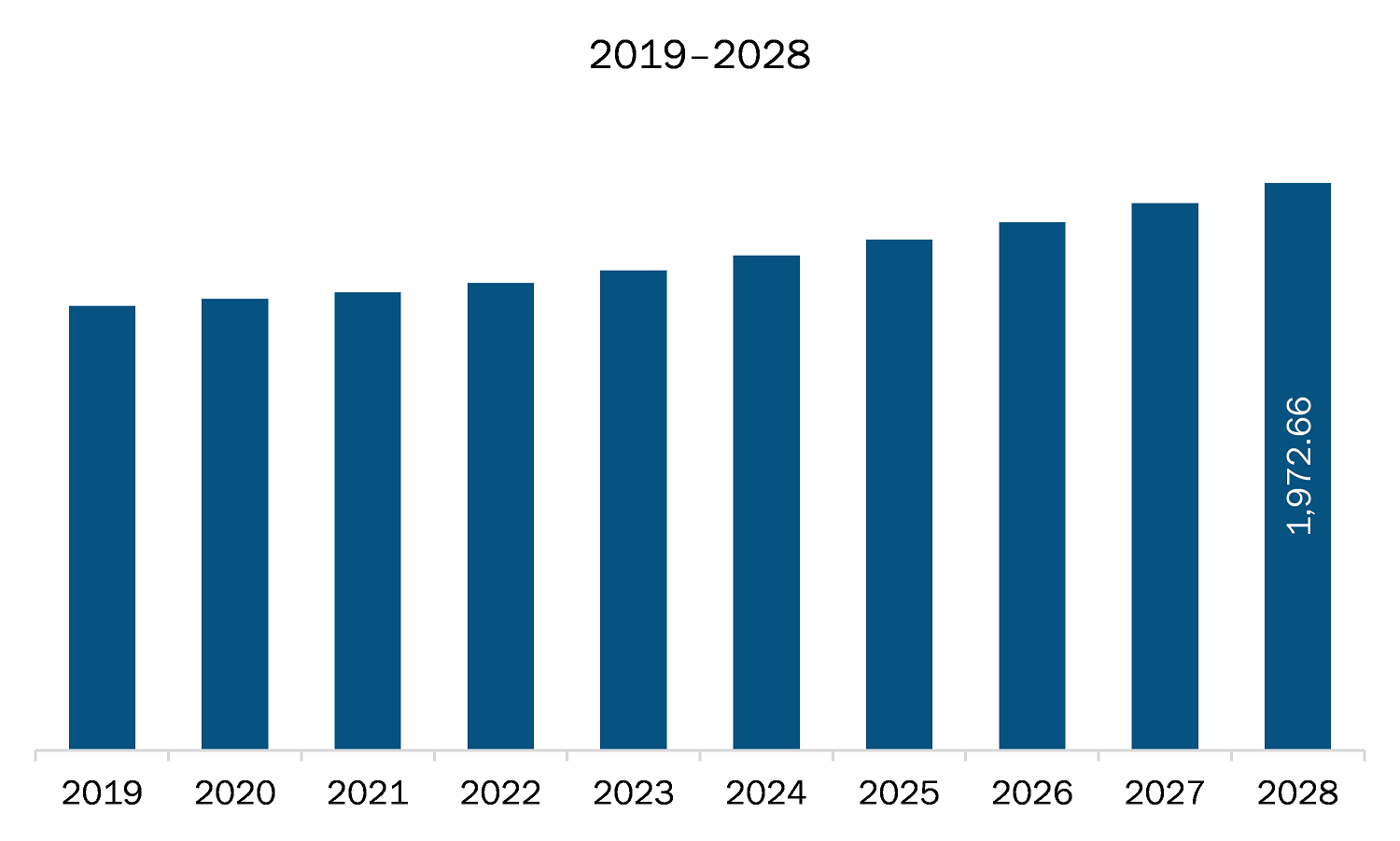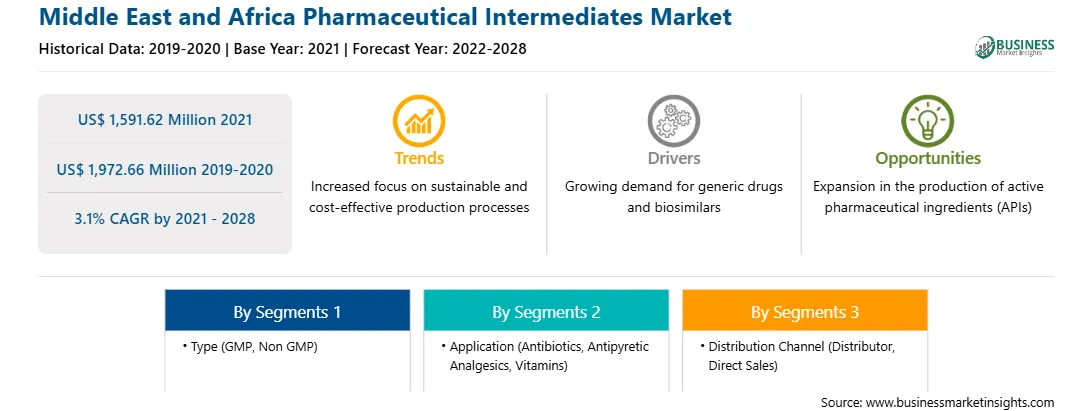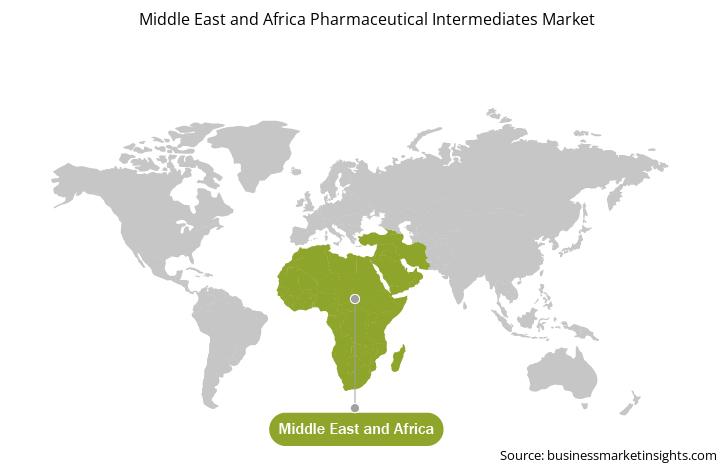Middle East & Africa consists of three major countries namely United Arab Emirates (UAE), Saudi Arabia and South Africa, and Rest of Middle East and African region. The market is driven by the factors such as increasing government initiatives, growing domestic production for pharmaceutical products, and rising business expansion by international players. Saudi Arabia is among the largest economies in the Middle East region. Country's economy is most flourishing, which is supported by the diversified initiatives and increasing population. The growing demand for generic production and increasing international players' expansions into the country have provided substantial growth for the pharmaceutical industry. Additionally, the country-based companies have initiated importing raw materials for producing a generic version of the foreign-made branded medicines. Some of the country's leading manufacturers include Al Jazeera Pharmaceutical Industries, AJA Pharma, Banaja Saudi Import Company, Saudi Arabian Japanese Pharmaceutical Company (SAJA), Saudi Pharmaceutical Industries (SPI), SPIMACO, Tabuk Pharmaceuticals, and Al Jazeera Pharmaceutical Industries. Increasing adoption of AI-based tools for drug discovery is the major factor driving the growth of the MEA pharmaceutical intermediates market.
Countries in the Middle East have also widely affected the socio-economic condition by the COVID–19 pandemic. However, the countries have wisely reacted to the COVID–19 pandemic to avoid the spread of infection. COVID-19 infections are rising in Iraq, with 932,899 reported cases as of April, 2021. There have been 14,757 deaths due to coronavirus reported in the country since the pandemic began. Similarly, COVID-19 infections are growing in Jordan, with 4,266 new infections reported on an average each day. As of April 2021, there have been 669,300 infections and 7,855 coronavirus-related deaths in Jordan since the COVID pandemic began. Thus, the number of coronavirus cases are increasing in the region. The Middle East and Africa region include countries such as South Africa, the UAE, and Saudi Arabia. These countries have also registered a significant number of positive coronavirus infection cases. These regions are developing in terms of the pharmaceutical industry. The countries in these regions are highly dependent on pharmaceutical products imported from developed countries. Therefore, countries have faced several challenges for their requirements during the pandemic. The lockdown has affected the supply chain of various companies in these regions. However, as the crisis continues and government relaxations on the import of the pharmaceutical intermediates products are expected to witness significant growth in the number of orders. However, as per the pharmacists in Riyadh, there is increased demand for nutritional supplements in Saudi Arabia since the outbreak of coronavirus in Saudi Arabia. The Health Ministry is coordinating with pharmacies to limit the quantity of nutritional supplements. Only one pack per customer should be sold in order to prevent the shortage for such items. This is likely to favor the growth of the pharmaceutical intermediates market.

Strategic insights for the Middle East and Africa Pharmaceutical Intermediates provides data-driven analysis of the industry landscape, including current trends, key players, and regional nuances. These insights offer actionable recommendations, enabling readers to differentiate themselves from competitors by identifying untapped segments or developing unique value propositions. Leveraging data analytics, these insights help industry players anticipate the market shifts, whether investors, manufacturers, or other stakeholders. A future-oriented perspective is essential, helping stakeholders anticipate market shifts and position themselves for long-term success in this dynamic region. Ultimately, effective strategic insights empower readers to make informed decisions that drive profitability and achieve their business objectives within the market.

| Report Attribute | Details |
|---|---|
| Market size in 2021 | US$ 1,591.62 Million |
| Market Size by 2028 | US$ 1,972.66 Million |
| Global CAGR (2021 - 2028) | 3.1% |
| Historical Data | 2019-2020 |
| Forecast period | 2022-2028 |
| Segments Covered |
By Type
|
| Regions and Countries Covered | Middle East and Africa
|
| Market leaders and key company profiles |
The geographic scope of the Middle East and Africa Pharmaceutical Intermediates refers to the specific areas in which a business operates and competes. Understanding local distinctions, such as diverse consumer preferences (e.g., demand for specific plug types or battery backup durations), varying economic conditions, and regulatory environments, is crucial for tailoring strategies to specific markets. Businesses can expand their reach by identifying underserved areas or adapting their offerings to meet local demands. A clear market focus allows for more effective resource allocation, targeted marketing campaigns, and better positioning against local competitors, ultimately driving growth in those targeted areas.

The pharmaceutical intermediates market in MEA is expected to grow from US$ 1,591.62 million in 2021 to US$ 1,972.66 million by 2028; it is estimated to grow at a CAGR of 3.1% from 2021 to 2028. Pharmaceutical intermediates are the building blocks of active pharmaceutical ingredients (APIs). These are raw materials that undergo molecular change or processing during bulk drug production. Thus, the requirement of pharmaceutical intermediates increases with the rise in demand for drugs to treat chronic diseases. The surging prevalence of infectious diseases, especially in Southeast Asia, is also likely to propel the demand for APIs in the coming years, eventually driving the growth of the pharmaceutical intermediate market. Thus, such high prevalence of chronic diseases and infectious diseases is bolstering the demand for drugs, eventually highlighting the need of pharmaceutical intermediates.
The MEA pharmaceutical intermediates market is segmented on the bases of type, application, distribution channel, and country. Based on type, the market is segmented into GMP and Non GMP. The GMP segment dominated the market in 2020 is expected to be the fastest growing during the forecast period. On the basis of application, the pharmaceutical intermediates market is segmented into antibiotics, antipyretic analgesics, vitamins, and others. The others segment dominated the market in 2020 and vitamins segment is expected to be the fastest growing during the forecast period. On the basis of distribution channel, the pharmaceutical intermediates market is segmented into distributor and direct sales. The direct sales segment dominated the market in 2020 and distributor segment is expected to be the fastest growing during the forecast period.
A few major primary and secondary sources referred to for preparing this report on the pharmaceutical intermediates market in MEA are company websites, annual reports, financial reports, national government documents, and statistical database, among others. Major companies listed in the report are BASF SE; chiracon GmbH; Codexis; Dishman Carbogen Amcis Ltd; Midas Pharma GmbH; Pfizer Inc.; and Sanofi are among others.
The Middle East and Africa Pharmaceutical Intermediates Market is valued at US$ 1,591.62 Million in 2021, it is projected to reach US$ 1,972.66 Million by 2028.
As per our report Middle East and Africa Pharmaceutical Intermediates Market, the market size is valued at US$ 1,591.62 Million in 2021, projecting it to reach US$ 1,972.66 Million by 2028. This translates to a CAGR of approximately 3.1% during the forecast period.
The Middle East and Africa Pharmaceutical Intermediates Market report typically cover these key segments-
The historic period, base year, and forecast period can vary slightly depending on the specific market research report. However, for the Middle East and Africa Pharmaceutical Intermediates Market report:
The Middle East and Africa Pharmaceutical Intermediates Market is populated by several key players, each contributing to its growth and innovation. Some of the major players include:
The Middle East and Africa Pharmaceutical Intermediates Market report is valuable for diverse stakeholders, including:
Essentially, anyone involved in or considering involvement in the Middle East and Africa Pharmaceutical Intermediates Market value chain can benefit from the information contained in a comprehensive market report.